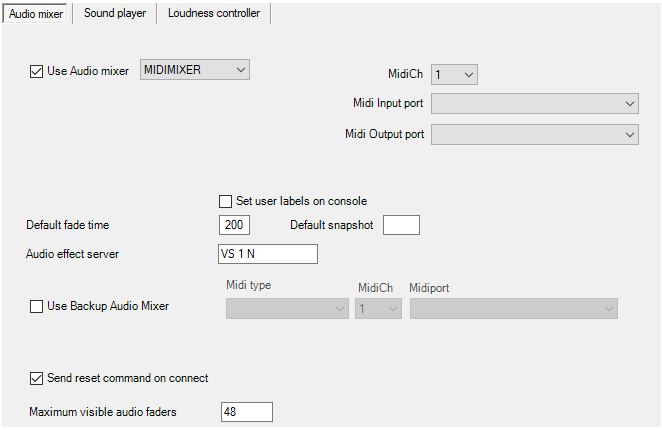
Viz Mosart Administrator Guide
Version 5.0 | Published June 21, 2022 ©
AV Automation Devices Audio
Viz Mosart connects to a variety of audio devices, from various manufacturers.
Select the required audio device from AV Automation > Devices > Preferences > Audio.
Audio Mixer
This tab enables setting-up of the main mixer and optionally, a backup.

-
Use Audio mixer: Enables the audio mixer functionality.
Audio Mixer Types
|
Audio mixer |
Protocol |
Supported hardware |
Interface |
|
CALCREC |
RAP |
|
RS-422, TCP/IP (Artemis) |
|
DHD |
DHD RM4200-D v2.02 |
|
TCP/IP |
|
EUPHONIX |
RAP |
|
COM |
|
LAWO RMNOPL |
RemoteMNOPL |
Lawo mc² |
TCP/IP |
|
LAWO ZIRKON |
RAS, Lawo Zirkon subset |
|
|
|
LAWO EMBER+ |
Ember+ |
|
TCP/IP |
|
MIDIMIXER |
Sanford.Multimedia |
|
MIDI |
|
SSL |
Light Broadcast Automation protocol, SSL Broadcast Automation Control Specification – v1.0 |
|
RS-422 or TCP/IP |
|
STAGETEC |
Stagetec Diamond RAS protocol, Monitora RAS |
|
COM |
|
STUDER_3000 |
Monitora + Ember, Ember 1.0 |
Studer OnAir 3000 |
RS-232 or TCP/IP |
|
STUDER_VISTA |
Ember |
Studer Vista |
TCP/IP |
|
VIZENGINE |
n/a |
Viz Opus only |
TCP/IP |
|
WHEATSTONE |
Wheatstone Mixer Automation Protocol v.1.4 |
|
TCP/IP |
|
YAMAHA_O2 |
MIDI |
Yamaha 01V96, DM1000, DM2000, DME64N, O2V96, LS9, CL5 |
MIDI |
|
vizrt-ips |
NewTek |
Vizrt Group/NewTek IPseries mixers. TriCaster, VMC, Viz Verdi, Viz Vectar |
TCP/IP |
-
Serial (Calrec, Lawo, Studer, etc.): Serial port connected to the audio mixer, when Serial radio button is selected.
-
TCP/IP: Hostname or IP address and port to communicate with the audio mixer, when TCP/IP radio button is selected. Note that for Calrec it is possible to configure a main and backup audio mixer by specifying two comma separated hostname values and port values.
-
Backup hostname and port (LAWO RMNOPL): Hostname (or IP address) and port to the backup audio mixer console.
-
Set user labels on console: When selected, user labels on the Lawo or Vista console are overwritten.
-
MidiCh (MIDIMIXER and YAMAHA_O2): MIDI channel assigned to the audio mixer.
-
Midi Input port (MIDIMIXER and YAMAHA_O2): System MIDI input port to communicate with the audio mixer.
-
Midi Output port (MIDIMIXER and YAMAHA_O2): System MIDI output port to communicate with the audio mixer.
-
Default fade time: Time in frames for fading open faders with the manual fade function (CTRL+F).
-
Default snapshot: Snapshot to recall when starting the automation (MIDI parameter change).
-
Audio effect server: Name for the Audio effect fader. This fader will open if effect transitions are used.
-
Send reset command on connect: Used for STUDER3000 SW 2.2, or lower. Recalls a default setup for the Mixer panel.
-
Visible audio faders: Maximum visible faders in AV Automation.
AV Automation Audio Mixer Availability Table
|
|
Serial |
TCP/IP |
MidiCh |
Midiport |
Hostname |
Port |
Backup |
Backup |
Faderinput |
Useember |
Comport |
|
CALREC |
x |
x |
|
|
x |
x |
|
|
|
|
x |
|
DHD |
|
x |
|
|
x |
x |
|
|
|
|
|
|
EUPHONIX |
x |
|
|
|
|
|
|
|
|
|
x |
|
LAWO |
|
x |
|
|
x |
x |
x |
x |
|
|
|
|
LAWO |
x |
x |
|
|
x |
x |
|
|
|
|
x |
|
LAWO EMBER+ |
|
|
|
|
x |
x |
|
|
|
|
|
|
MIDI |
|
|
x |
x |
|
|
|
|
|
|
|
|
SSL |
x |
|
|
|
|
|
|
|
x |
|
x |
|
STAGETEC |
x |
x |
|
|
x |
x |
|
|
|
|
x |
|
STUDER |
x |
x |
|
|
x |
x |
|
|
|
x |
x |
|
STUDER |
|
x |
|
|
x |
x |
|
|
|
|
|
|
VIZ |
|
x |
|
|
x |
x |
|
|
|
|
|
|
WHEAT |
|
x |
|
|
x |
x |
|
|
|
|
|
|
YAMAHA |
|
|
x |
x |
|
|
|
|
|
|
|
|
Vizrt |
|
x |
|
|
x |
x |
|
|
|
|
|
Sound Player
A basic audio player is always included as standard in a Viz Mosart.
-
User actions are presented in the Viz Mosart User guide in section Playing Audio.
Requirements
-
Refer to general section Prerequisites.
Setting Up a Sound Player
-
Refer to section Audio Players.
Loudness Control
A loudness control from Junger.

-
Use loudness controller: Check the box to enable loudness control.
-
Loudness controller type: JUNGER T*AP.
-
Triggers/levels: Name of triggers or loudness levels, one for each line. These will appear in a tool-tip menu in the Template editor, and must correspond to the configuration in the loudness controller(s).
-
Channels: Fixed values. For Junger T*AP there are four stereo channels per host. Connections to the audio faders are configured in A/V Setup/Edit/Audio config/Loudness channel.
-
Host:port: Hostname or IP address and optional port number for each controller.
Note: If the root node name is different than T*AP the name must be set in the AVA configuration property JungerRoot .
See Also